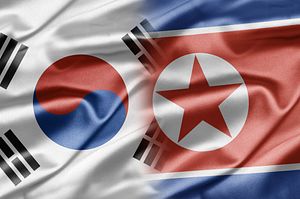South Korean officials confirmed on Wednesday that its marines have taken down a 43-year old giant steel Christmas tree in Gimpo, South Korea, northwest of Seoul, near the North Korean border. Despite its benign appearance, North Korea considered the steel Christmas tree a sign of religious propaganda by South Korean Christians and repeatedly threatened to attack it with artillery. The tower hasn’t been lit since 2004, except for temporarily lightings in 2010 following the sinking of the ROKS Cheonan and again in late-2012 following a North Korean long-range missile launch.
The New York Times describes the Christmas tower’s legacy as part of the psychological warfare the two Koreas waged following the conclusion of the Korean War with a truce in 1953. Both “sides carved their border hills with large slogans exhorting opposing troops to defect to the capitalist South ‘for freedom’ or to the ‘people’s paradise’ of the communist North. They also used radio broadcasts and balloons carrying propaganda leaflets.”
KCNA, North Korea’s state news agency, issued a commentary on Christmas Eve 2012 describing the tree as “an open challenge and an unpardonable provocation against the DPRK.” It added that the “psychological warfare conducted by the military warmongers in the tension-charged forefront areas is a dangerous act aimed to ignite a war against the DPRK.”
South Korean officials denied that the dismantling of the tree had anything to do with South Korea’s bid to draw North Korea into a high-level dialogue, or with recent inter-Korean skirmishes. Following an impromptu high-level visit to South Korea by three North Korean officials close to Kim Jong-un at the conclusion of the 2014 Asian Games, South Korea has additionally invited North Korea to an October forum aimed at implementing South Korean President Park Geun-hye’s plan for peace in Northeast Asia. South Korean officials maintain that the tree was taken down due to concerns about its structural integrity.
The dismantling of the Christmas tower could be interpreted as the South Korean government stepping in to interfere with civic groups’ activities against the North. Starting in the late-2000s, South Korean conservative activists began sending balloons with leaflets attached over the border to North Korea. The South Korean government feared retaliation by the North, but could not officially step in to ask these civic groups to cease their activity. The Christmas tower occupied a similar position — it was decorated by civilians, but was maintained by South Korean marines.

































